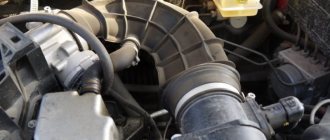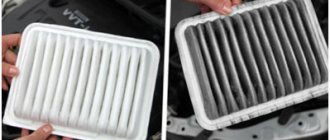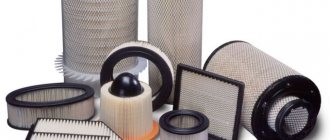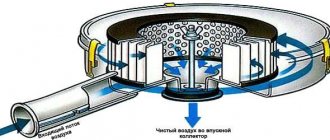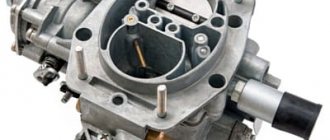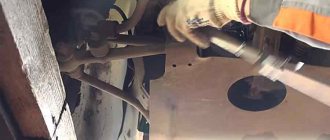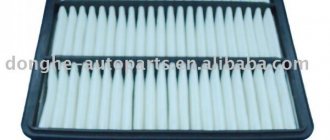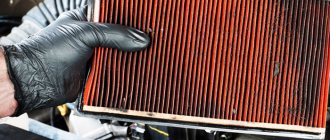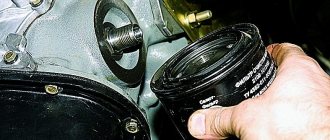Many car enthusiasts are very sensitive to the issue of maintaining their car and in most cases even have a good understanding of the structure and operating principle of its main units. However, there are a number of minor parts and systems that car owners do not pay due attention to, considering them to be of little importance. For example, almost any car owner will certainly take care of timely replacement of the air filter, which is part of the engine intake system. But the need to replace the filter element, which is responsible for cleaning the air entering the car interior, is often forgotten. Some drivers are not even aware of its existence until they become familiar with the maintenance regulations. So, in this article we’ll talk about the car cabin filter.
Before we begin to consider the design and operation of modern cabin filters, let us briefly recall the history of the appearance of these air purifiers. Interestingly, they began to be used much later than classic air filters designed to clean the flows entering the engine intake manifold. Awareness of the need to filter the air entering a car came in the late 70s - early 80s, when the number of vehicles began to rapidly increase and the first traffic jams began to appear, around which a cloud of exhaust gases was literally created. The first cabin filter was installed on a production car in 1991. It was a filter paper that captured particles larger than 5 microns and was powerless in the fight against toxic gases. In the second half of the 90s in Europe, cabin filters began to be installed en masse on cars in the mid-price category. These were already more advanced filter elements with the addition of activated carbon, capable of absorbing molecules of harmful substances such as nitrogen oxides, sulfur and others. Currently, a cabin filter is an integral part of most cars. Only some budget models, and then, as a rule, in initial configurations, do not provide for the installation of such elements for air filtration.
Purpose of the cabin filter
We have already noted above that the cabin air filter is designed to remove various types of harmful substances that penetrate into the interior of the car through the air ducts of the ventilation system. Many will probably wonder why pay much attention to air filtration if it enters the cabin not only through the air intake, but also through gaps in the seals and simply when opening the car doors. This is true, however, excess concentrations of substances hazardous to human health are typical only for areas of heavy traffic, when the flow of traffic is quite dense and the speed of its movement is low. In this situation, the exhaust pipe of the vehicle in front is almost closely adjacent to the air intake of the vehicle moving behind. It is in the immediate vicinity of the exhaust gas system that the permissible concentration limits of harmful components can be exceeded by 10-15 times. If you take measurements a few meters from a car running outdoors, then the excess here will either be insignificant or not exist at all.
In addition to toxic substances, the car's cabin filter must capture particles of dust, soot, and rubber. These particles are quite large and problems with filtering them out usually do not arise even with the simplest filter elements, so we will not dwell on them, but rather pay attention to the more elusive combustion products.
Exhaust gases contain a whole host of harmful compounds that, at a certain concentration, have a negative impact on human health. We are talking about both immediate consequences such as headaches, involuntary sneezing and pain in the eyes, and the danger of developing serious chronic diseases in the future. The maximum permissible concentration of unfavorable chemicals is determined by GN 2.1.6.1338-03 standards, which establish the maximum single and average daily concentrations, as well as the hazard class of each substance. The table below presents some of the harmful components indicating the maximum permissible concentrations in ambient air.
| Substance | Chemical formula | Hazard Class | MPC single, mg/m3 | Average daily permissible concentration, mg/m3 | Physiological action |
| Carbon monoxide (carbon monoxide) | CO | 4 | 5.0 | 3.0 | Oxygen starvation, leading to headache, shortness of breath, decreased speed of psychomotor reactions |
| Nitric oxide | NO | 3 | 0.4 | 0.06 | Damage to the respiratory tract and lungs |
| Nitrogen dioxide | NO2 | 2 | 0.2 | 0.04 | |
| Benzopyrene | C20H12 | 1 | — | 0.1 µg/100 m3 | Carcinogen, can accumulate in the body |
| Hydrogen sulfide | H2S | 2 | 0.008 | — | Dizziness, headache, nausea |
| Benzene | C6H6 | 2 | 0.3 | 0.1 | Carcinogen, can cause headaches, nausea, dizziness. |
| Carbon black (soot) | C | 3 | 0.15 | 0.05 | Carcinogen |
| Formaldehyde | CH2O | 2 | 0.05 | 0.01 | Carcinogen, negatively affects the respiratory tract, mucous membranes, nervous system |
| Methane | CH4 | — | 50 | — | Oxygen starvation at high concentrations |
The most dangerous of these substances is carbon monoxide - a colorless, poisonous compound, tasteless and odorless. This gas is formed as a result of incomplete combustion of fuel, causing severe poisoning in large doses. In traffic jams, the permissible concentration of CO can be exceeded several tens of times, and, what is most unpleasant, almost none of the types of cabin filters can effectively combat carbon monoxide. So, if possible, it is better to avoid prolonged idle time in traffic jams, otherwise mild poisoning can be considered guaranteed. One of the options for preventing carbon monoxide from entering the cabin is to activate the recirculation mode, which eliminates the intake of air from outside.
Nitrogen oxides, which have a negative impact on the respiratory system, also make up a fair share of polluted urban air. NO compounds as a result of photochemical reactions with water in the atmosphere lead to the formation of nitric acid, which, together with precipitation, falls to the ground in the form of so-called acid rain. For car enthusiasts, consolation is the fact that any nitrogen oxides are successfully neutralized by cabin filters, although only those that contain activated carbon. It should be taken into account that the adsorption properties of carbon filters in terms of NO capture deteriorate during operation, which leads to a significant decrease in their operating efficiency.
Formaldehyde, which belongs to the family of aliphatic aldehydes, is a toxic, colorless gas with a pungent odor. At large dosages it can lead to poisoning, however, even in air heavily polluted by exhaust, its concentration rarely exceeds the maximum permissible values. In addition, carbon cabin filters cope very well with formaldehyde.
We will not dwell on other harmful substances in detail. Let us only note that all of them, be it aliphatic hydrocarbons (methane, ethylene and others) or ordinary soot, are well screened out by carbon cabin filters.
What's the point of a cabin filter?
The environmental organization Mosekomonitoring conducted a large-scale study on the effect of dirty air and exhaust emissions on the condition of drivers. The share of harmful substances on busy streets and avenues significantly exceeds the permissible limit. The basis of all harmful emissions are sulfur oxides, formaldehydes, carbon monoxide, nitrogen and harmful hydrocarbons. But despite such a number of harmful substances, the overall environmental picture in cities is considered favorable, because in residential and densely populated areas there is usually no such crazy traffic and emissions.
However, roads remain the most polluted and harmful places. If on the road the nitrogen concentration exceeds the norm three times, then in the cabin the norm is exceeded 6–7 times. And this is not the limit. And this contributes to the emergence of stress, aggression, nervous disorders and even chronic diseases.
The purpose of a cabin filter is to protect against dust and odors from the street.
Also, small particles of dust, in addition to the strongest harmful substances like carbon monoxide, which can lead to fainting, easily enter the car interior and make it difficult for the driver and passengers to breathe. Also, soot, tire dust, harmful salts - everything rises from the surface of the road surface and is sent to the cabin, and then into the human body. Many traffic accidents involve allergy sufferers who lose control due to uncontrollable attacks.
That is why, in order to reduce the amount of harmful substances that can easily enter the body, new clean air filters are installed. This is not a mandatory action, but it helps to avoid damage to the body.
Types of cabin filters
Cabin filters used in cars are divided into two most common groups:
- Conventional dust filters;
- Carbon filters.
Simple dust filters clean the air of dust and soot, as well as pollen and other allergens. These filters use paper or synthetic fiber as a filter element, which are capable of trapping particles up to 1 micron in size. Materials made from synthetic fibers can be electrified, therefore, in addition to mechanical retention, they have the ability to trap particles through attraction. The main difference between dust cabin filters and air filters for the engine power system is the lower density of the filter material. This is due to the fact that the car's ventilation system is not capable of creating such a strong draft, which is provided by the vacuum in the intake manifold. The disadvantages of dust cabin filters include their absolute helplessness in the fight against toxic gases and unpleasant odors.
Carbon cabin filters are capable of purifying the air from any harmful compounds, experiencing certain difficulties only with carbon monoxide. The working element of this type of filter is activated carbon, a porous substance with a large specific surface area. It is formed by many microscopic pores, the smallest of which are about one nanometer in size. It is due to these pores that the molecules of toxic gases in contact with activated carbon are captured, and the capture is carried out by large macro- and mesopores, and then transported to the micropores. This phenomenon is called adsorption. We will not delve into the nature of the emergence of intermolecular forces that make it possible to realize such a “sucking” of some substances by others; we will only note that the larger the molecules of the absorbed substance, the easier it is to capture and retain them. The effectiveness of adsorption by a carbon filter depends not least on factors such as flow rate and air temperature.
If we turn to the design features of cabin filters, the activated carbon used for them is granules about 0.5 mm in size, mounted on a special backing made of textile material. Most carbon filters have a multilayer structure, in which “carbon” layers alternate with layers of conventional anti-dust fiber. Each of the layers is responsible for trapping particles of a certain type and size. As a result, the air that has undergone multi-stage processing enters the cabin in an absolutely clean and safe form for inhalation.
The smell has nothing to do with it
There is an opinion that activated carbon in the cabin filter is only needed to absorb odors. This is true, but only partly. In fact, the absorption of odors is a side effect, a free bonus if you will.
The main task is not to allow nitrogen oxides (which, by the way, caused a Volkswagen fire at the diesel gate), ozone, carbon monoxide and sulfur dioxide to enter the cabin. These are substances that are very harmful to human health, which the filter is actually supposed to absorb - it is them, and not some odors. Therefore, assessing the performance of a filter by whether it allows odors to pass through or not is incorrect.
Where is the cabin filter located and how to replace it
Despite the fact that cars from different manufacturers have significant design differences, they usually use cabin filters of the same shape. Usually this is a rectangular cassette with a characteristic corrugated filter element and a more or less rigid frame around the perimeter, ensuring installation without distortions while maintaining the required tightness of the edges. The installation locations for cabin filters also do not vary much. They are usually found either in the engine compartment or under the dashboard in the passenger seat area (often behind the glove box). Only its operating manual can answer the question of where the cabin filter is located in a specific car model. It also describes the sequence of actions for replacement.
The procedure for replacing the cabin filter itself may require different labor costs depending on the car. For example, owners of a Toyota Corolla will not have to make a lot of effort to perform this action. In this case, the air conditioning unit into which the cabin filter is inserted is located immediately behind the glove box. The latter can be folded back by removing the side stop and squeezing the box itself on both sides. Access to the cabin filter has been gained, so now it is enough to remove the old cassette and replace it with a new one.
On some models there are certain nuances associated with replacing the cabin filter. For example, in some cases it is not so easy to get to the location of the filter element, so during installation there is a risk of jamming any edge of the filter or not fitting it tightly enough into the fixation block. It is clear that the appearance of even a minimal gap in the filtration zone will lead to a clear decrease in the efficiency of the cleaning system. Another point that no longer depends on the car is the need to take into account the direction of air flow. The corresponding arrows marked on the side faces of the element will help you install the cabin filter properly.
How to know when it's time to change the cabin filter
It all depends on the operating conditions of the car. If you often drive on dusty roads, the service life of the filter will be significantly reduced.
The main signs of the need to replace the cabin filter:
- Increased humidity levels in the cabin, which leads to fogging of the windows. Occurs due to water getting into the filter. This usually happens with Russian or Chinese products.
- Deterioration of the ventilation system; the air flow is not as intense as after installing a new filter.
- The appearance of an unpleasant odor in the car interior.
- Deterioration in the performance of the air conditioner - at maximum power it does not cool the interior well.
- Deterioration in the operation of the stove - it does not warm up the interior well even at high settings.
If you notice at least one of the signs, contact a specialist or change the filter yourself. We'll talk about the replacement procedure further.
How often to replace the cabin air filter
During operation, the cabin filter inevitably becomes clogged, so sooner or later it will need to be replaced. The vehicle manual indicates a specific interval for replacing the filter element, tied to the implementation of scheduled maintenance. However, it is advisable to carry out this procedure based on the actual condition of the cabin filter, since it depends on a number of factors. Obviously, replacement will have to be made more often if the car is operated in conditions of heavy dust or gas pollution. For example, the filter will obviously become unusable faster if you regularly drive on dirt roads, where the concentration of various types of particles in the air is much higher than on lightly trafficked city streets. A large load on the cabin filter also falls in large cities, literally drowning in smog from emissions from cars and industrial enterprises. The service life of the cabin air filter is also influenced by the type of material from which it is made. Higher quality filter elements are able to function normally even after 15-30 thousand kilometers, while a fake will not last even half of this period.
There are several signs that indicate the need to replace the cabin filter:
- Reduced performance of the ventilation system, i.e. the air flow from the deflectors has become less intense than before;
- The appearance of a persistent odor in the cabin, clearly not associated with external sources;
- Increased fogging of windows.
To save money, many car enthusiasts prefer to clean cabin filters with their own hands and then reuse them. The idea, it must be said, is unsuccessful, since no cleaning with improvised means can one hundred percent restore the original properties of the materials. This is especially true for carbon filters, the operating principle of which is based on very complex internal processes occurring at the molecular level.
Problems solved by the cabin filter
From the point of view of the evolution of the car, the cabin filter is, if not a baby, then certainly a kindergartener: it began to be installed en masse on production models around the early nineties, and the first generation copies were copies of their air counterparts. But since the cabin filter faces slightly different tasks, over time they have evolved into multi-layer protective devices, including, in addition to the standard anti-dust layer (or several such layers), also a layer with activated carbon. Thus, the first layer protects against the smallest particles of dust, pollen and microorganisms ranging in size from one micron, and the layer with carbon copes with a more complex task, preventing volatile gases and even bacteria from entering the car, preventing unpleasant odors from penetrating into the car. The cabin filter is enclosed in a square or rectangular frame (with the possible presence of one front or two side panels), inside of which there is an accordion-folded absorbent synthetic material. As a rule, replacing this consumable can be done independently and in most cases it does not require much experience or the use of a large number of tools. Nevertheless, there are models on which access to the SF is difficult, and its replacement may be associated with some difficulties.
We recommend: How to make and install heated seats with your own hands?
Any filter element becomes clogged over time. The cabin filter, like a regular air filter, is no exception. Dust and other pollutants, entering its micropores, get stuck there and impair the permeability of the filter material. This means that both the stove and the air conditioner will be forced to work at maximum power, and their efficiency will gradually decrease. This means that in the summer heat you will not be able to fully enjoy the saving coolness coming from the deflectors, and in winter the air from the stove will not warm you sufficiently, and over time the situation will only get worse. A clogged SF will cause the car windows to constantly sweat, regardless of the difference in temperature and humidity outside and inside the vehicle. Another argument in favor of timely replacement of the filter element is the appearance of an unpleasant odor in the cabin, associated with the accumulation of more and more bacteria on the contaminated surface of the filter material, the waste products of which will poison your time in the car more and more.
Note that carbon filters, which provide a greater degree of protection from harmful factors, become dirty faster than their anti-dust counterparts, requiring more frequent replacement. And they cost at least twice as much, so for most car owners, sooner or later the question arises of what to choose when replacing the cabin filter regularly (or extraordinarily, if this is indicated by obvious symptoms of contamination) - a carbon version or a dust one. Let's try to understand in more detail the features, advantages and disadvantages of both types of SFs.
Dust filter
This is the most affordable option, usually consisting of a single layer of material based on cellulose/synthetic fiber, enclosed in a rectangular or square frame (there are also quite exotic filter element geometries). To provide maximum surface area, this material is laid in accordion-style rows. Typically, the fiber density here is lower than that of its air filter counterpart. This is due to the fact that in the intake manifold during the air intake stroke the vacuum value is much higher than in the air line of the vehicle ventilation system. The task of a conventional FS is not to allow particles of dust, soot, rubber, large chemical compounds and plant pollen to pass through. For this reason, it is sometimes called an anti-allergen filter. Sometimes the surface of the filter element is impregnated with chlorine, giving it pronounced antibacterial properties. If synthetic material is used in the manufacture of SF, then due to static electricity it is possible to achieve better filtration of dust particles.
Advantages of a regular SF:
- reducing the degree of glass fogging;
- the possibility of using the fan in contaminated places (tunnels, traffic jams, industrial areas);
- ability to retain debris up to 1 micron in size;
- filtering bacteria, plant spores and pollen;
- affordable price.
Among the disadvantages are the following:
- inability to handle hazardous/harmful chemicals, toxic gases;
- inability to resist the penetration of foreign odors into the cabin.
Carbon filters
Now let’s look at how a carbon cabin filter differs from a regular dust filter. First of all, the presence of several layers, since the usual SF is single-layer. There can be two or three layers, with the first and thickest being a classic filter element designed to retain relatively large fractions of pollutants contained in polluted air. The second layer, which may not exist, consists of a finer-mesh fiber capable of absorbing much smaller particles (the same pollen, for example). The third layer is activated carbon. A substance well known for its unrivaled adsorption properties. It is the carbon part of the filter that is responsible for retaining gases and volatile molecular compounds, from nitrogen and sulfur oxides, which are components of automobile exhaust, to hydrocarbon substances representing the phenolic or benzene subgroups. Many of these substances, being carcinogens, enter the human body, linger in the lungs and penetrate the blood, causing intoxication.
Coal FS allows you to solve this problem, relieving those inside the car from the risk of inhaling poisoned air. Advantages of a cabin carbon filter:
- the ability to operate the climate system in polluted places (tunnels, traffic jams, industrial areas);
- reduction of fogging of car windows;
- a degree of filtration unattainable for conventional SF (up to 95%!);
- absorption of volatile compounds;
- suppression of unpleasant odors.
Among the disadvantages, it is worth noting the high cost (at least twice as expensive as anti-dust analogues), lower throughput and faster clogging.
conclusions
From all of the above, we can draw an unambiguous conclusion: the cabin filter is a necessary component, the timely maintenance of which is the key to maintaining a pleasant atmosphere inside the car, eliminating the risk of minor ailments and serious diseases. When choosing an air purifier, you should pay attention to products from well-known brands that are in a higher price category. This is exactly the case when you can overpay and get obviously higher quality products that perform their functions many times better and at the same time maintain their functionality over a range of up to several tens of thousands of kilometers. When choosing between dust and carbon cabin filters, preference should be given to the latter, because they are more effective at resisting toxic substances.
Where is the cabin air filter located in the car?
The location of the cabin filter depends on the design of the vehicle. On older cars, this element is mainly installed in the module where the heater motor is located. For example, a car of the SAMARA family will be equipped with a cabin filter, which is located in the engine compartment behind the partition of the engine compartment under the windshield.
In more modern cars, this adapter is installed either in one of the walls of the glove compartment or under the dashboard. More accurate information regarding a specific car can be obtained from the owner's manual for the car.
How to change the filter yourself
First of all, you need to figure out where this part is installed. The dismantling procedure will depend on this. This data is indicated by the manufacturer in the machine manual. Typically this job will not require any tools. Basically, the module has a cover that is fixed with a plastic fastener (you can press it out with your fingers).
